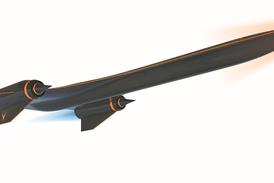Mobile satellite communications company steps closer to offering broadband services to airlines after 1-4 launch
Following the successful launch from Florida's Cape Canaveral of the first Inmarsat 4 (I-4) communications satellite, the countdown has begun to offering broadband services to airlines in Europe, Asia, Africa and the Americas by the second quarter of 2006. These services and their schedule should be the subject of an announcement in May by London-based satellite operator Inmarsat, along with several major airlines.
A constellation of three I-4 satellites, built by European manufacturer EADS Astrium, will provide Inmarsat's Broadband Global Area Network (BGAN). The 6,000kg (13,200lb) spacecraft will deliver a 3G-compatible service to mobile users via the C and L frequency bands with 60 times the power and 20 times the broadcast capacity of its Inmarsat 3 predecessor. Each satellite can produce 19 wide beams and 228 spot beams, each covering 400km (250 miles). The Inmarsat 3 (I-3) model, in comparison, has seven spot beams. Each I-4 spot beam can focus enough power to deliver remote access. This power means even small devices, such as personal digital assistants, could receive BGAN services.
Launched by International Launch Services' Atlas V on 12 March, I-4 Flight 1 (F1) will be joined in the third quarter of the year by I-4 F2, to be launched by Sea Launch. The third and final satellite, I-4 F3, should go up in 2006, but Inmarsat has not yet begun negotiations with a launch provider.
I-4 F1 will cover Africa, most of Asia Pacific, Europe, the Indian sub-continent, the Middle East and Western Australia. The location over the Indian Ocean was chosen in preference to the Atlantic because it enables Inmarsat to end its use of a leased satellite. I-4 F2 will be positioned over the Atlantic Ocean Region-West, at 53°W, covering the Americas, the Atlantic and western parts of Europe and Africa. I-4 F3, if it is launched, will be at 178°E above the Pacific Ocean Region. F3 was originally intended to be a spare if something went wrong with F1 or F2, but demand, particularly from airlines for Pacific coverage, could lead to its deployment. This represents a risk if in-flight internet demand is not what everyone expects.
High speed
The I-4 constellation will enable cabin and cockpit services such as in-flight email and internet access at higher data speeds than are provided by Inmarsat's Swift64, a 64kb/s service. The higher-speed service using the BGAN backbone is called Swiftbroadband and can be received by aircraft using existing Inmarsat Aero H/H+ antennas. Inmarsat says a typical Swiftbroadband user could receive data at up to 432kb/s. Swift64 users may require hardware, as well as software, upgrades to access the new service, which can be billed as broadband because, under the US Federal Communication Commission's definition, an information service is broadband if it has a capacity in excess of 200kb/s.
Swiftbroadband will be provided through distributors. For example, Xantic, which operates in the Netherlands and Australia, was selected as a distributor last October. Inmarsat has also been working with airline telecommunications specialist Arinc and Norwegian telecommunications company Telenor on their in-flight GSM mobile-telephone service, and with Airbus joint-venture OnAir. OnAir aims to use BGAN to widen its product range, adding more voice and data options, internet and corporate network access, while meeting mobile demand and keeping telephony costs at terrestrial international roaming rates.
"[I-4's] high capacity will be able to support the number of mobile phone calls expected at peak times on both short and long flights," says OnAir. Competitor Connexion by Boeing already offers users a 256kb/s capability, which is now operating on aircraft owned by Lufthansa, All Nippon Airways, Japan Airlines and SAS. Connexion requires a dedicated phased array or mechanically steerable antenna.
In 10 years' time, Boeing hopes to have around 4,000 aircraft using the service. However, 7,000 aircraft are already equipped with antennas for Inmarsat's aeronautical satcom service, including 50% of all long-haul aircraft.
But Connexion is already up and running and Swiftbroadband is behind schedule. I-4 F1's launch was supposed to be in October 2004, and the delay has had cost implications. "We have mitigated [the cost] within the budget," says Inmarsat chief executive officer Andrew Sukawaty. "The delay was due to development and testing, and then the launch window."
Assuming there are no more delays, 2006 will see Inmarsat's in-orbit fleet expand from nine satellites to 11 or 12 with the I-4 constellation in place. The existing nine comprise four Inmarsat 2s and five I-3s. These satellites carry the 64kb/s Global Area Network (GAN), 144kb/s Regional BGAN (RBGAN) and satellite phone mini-M services.
These will be moved to the I-4s initially. GAN will be moved to I-4 F1 as soon as it is commissioned. RBGAN will follow, probably during the second quarter. RBGAN customers can switch to BGAN with only a software upgrade. Finally, the mini-M service will also use I-4s, but as all the satellites are viewed as a single network, users will not notice any change.
Annual growth
With 70% of Inmarsat's revenue now from data and a year-on-year growth of 15% in data demand, the rise of airborne internet access is likely to follow the trend. However, the company does not expect airline services to be more than a small proportion of its revenue. Aeronautical revenues for Inmarsat are 3% of its total income. The company says I-4 F1, F2 and F3 will assure its orbital infrastructure to the end of the next decade. Each I-4 has an expected 13-year life, lasting to 2018 at least.
Source: Flight International























